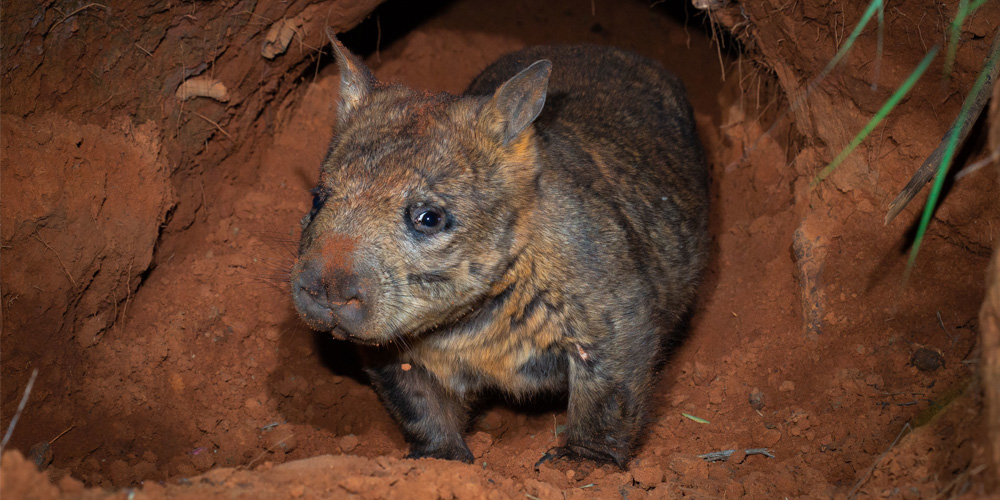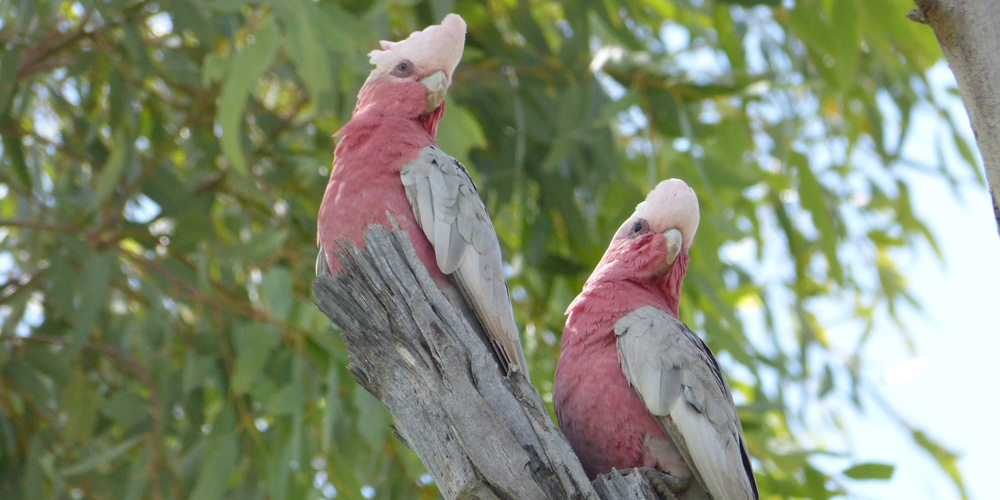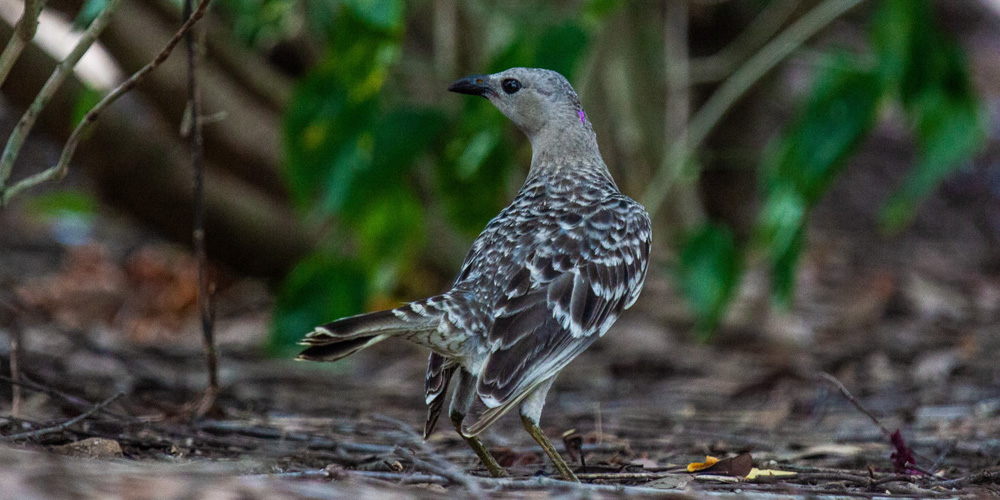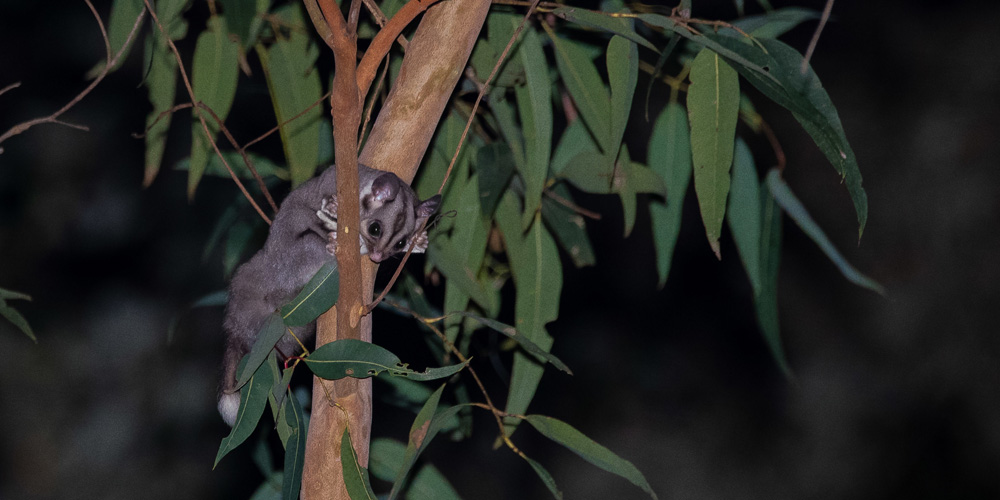From elaborate nesting displays to fleeting encounters, the mating rituals of Australian wildlife are as unique as the species themselves. Various species are known to mate for life, raising young together every year, often at the same nesting sites. Others prefer a more…bachelor lifestyle… remaining on their own until the time is (fleetingly) right.
This Valentine’s Day, we’re taking a closer look at the unique methods Australia’s native animals use to attract “the one”.
Northern Hairy-nosed Wombat: Live-in lovers, but only short-term
There is limited information available on the behaviour of the critically endangered Northern Hairy-nosed Wombats. There are only 315 individuals remaining in two population pockets, but they are incredibly hard to study, as they tend to keep to themselves, spending a lot of time underground in their burrows and only emerging at night to feed.
 Brad Leue/AWC
Brad Leue/AWC
Each Wombat has their own burrow, which they either design and bulldoze themselves or renovate after a previous tenant has moved out. These burrows are marked with urine, cube-shaped dung, and scratches – a welcome mat of sorts – that lets other Wombats in the area know that this burrow is occupied.
However, it is these expansive underground mansions (the largest mapped burrow contained more than 90 metres of tunnels and six entrances!) that, during mating season, become a home for more than one. The arrangement is only temporary though, and by the time the gestation period of 21 days is over, the housemate has moved out.
Solitary they may be, but Northern Hairy-nosed Wombats are monogamous, and will only breed with the one partner each season.
Galah: lifetime lovers
Also known as the Rose-breasted Cockatoo, Galah form permanent pair bonds which can span their entire lifetime of up to 50 years. They are a very social and affectionate species and will spend most of their time together in pairs, eating, cleaning, and playing together.
 Alison Muirhead/AWC
Alison Muirhead/AWC
Galah will usually nest in Gum trees in hollows or holes. Bonded Galah pairs will continue to return to the same nest site every year, with both parents working together to get the nest ready for the eggs by lining it with soft eucalyptus leaves.
During the breeding season, males will put on a display for their female companion by strutting, bobbing and waving their heads and raising their crest, giving soft calls, and also clicking their bill.
Koala: Love in low frequency
Found throughout Eucalypt forest across Australia, Koalas are solitary animals, each with their own home range which can span a few acres to hundreds of acres. While these home ranges may overlap, Koalas rarely run into one another, except when breeding.
A male Koala is proof that it is not only songbirds that get the girl. During the breeding season, which begins in September and ends toward the end of April, these bush baritones belt out deep, rumbling, grunting calls which echo across the tree line.
Though it’s not entirely clear how things play out, scientists think when a female hears a bellow she likes, she will go on an excursion to find him in his home range. It was previously thought that female Koalas chose a mate by size, but DNA testing has now shown that this is not the case and females will breed with different males each year. It seems she is listening for a different bellow and chooses her mate from his song.
Bowerbirds: The love architects of the bird world
To attract the female of his dreams, a male Bowerbird will participate in extraordinarily complex courtship and mating behaviour… he will build a bower elaborately decorated with bright shells, flowers, and sticks to catch her attention. Like a shrine on the forest floor, bowers are either avenues, made of two walls of vertically placed sticks, or maypoles, where a series of sticks are woven around a central pole. Avenue bowers can be up to two metres long.
Males spend hours arranging their collection and making sure everything is just right. They may even steal from nearby bowers for that perfect piece that is missing from his hoard.
 Sally Gray/AWC
Sally Gray/AWC
Once the bower has perked her interest, the female Bowerbird will inspect the structure multiple times to see if the design meets her standards. During their visit, she is subjected to highly theatrical displays from the male including chirping, whistling, and buzzing while he performs ‘rooster’ or ‘penguin’ walks.
She won’t buy into the first house on the block though – visiting multiple sites, and often returning to preferred bowers several times, while she builds her nest nearby.
Sugar Glider: Pocket-sized love bugs
Sugar Gliders are happiest when they are getting love from – and giving love to – somebody else. They are very social animals and live in family groups, with multiple adults accompanied by the young from that season. Active at night, they spend the day sleeping in cuddle puddles in a nest made of leaves in tree hollows.
 Brad Leue/AWC
Brad Leue/AWC
Mating occurs in July and August, and just 16 days later two babies are born. Sugar Gliders commonly give birth to twins, which remain in the pouch for just over two months. They then leave the nest to forage for food, usually with their mother. If conditions are favourable Sugar Gliders may produce more than one litter in a year.
Both Sugar Glider parents engage in parental care of their offspring. This arrangement allows one adult to keep the young warm in the hollow while the other parent is out foraging for food.
Help AWC provide hope for these and many other species
Donate now